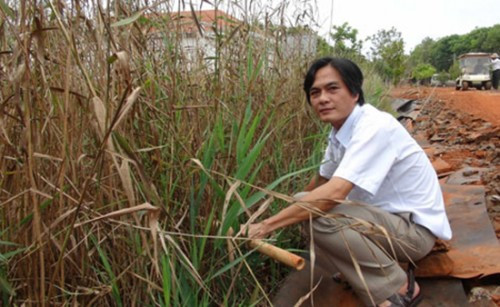Unique 'technology' hospital wastewater treatment with reeds
A waste water treatment system that is completely based on nature, does not cost much investment or maintenance costs but does not yield inferior to other wastewater treatment systems. These are the special advantages of reed waste water treatment model - the model is being applied effectively at Nhan Ai Hospital (Phu Van commune, Bu Gia Map district, Binh Phuoc).
According to Dr. Nguyen Thanh Long - Director of Nhan Ai Hospital, the reed waste treatment model by the Ho Chi Minh City Department of Health is the investor and Nhan Ai Hospital is the beneficiary unit started. implemented from 2012 with a total investment cost of about 4 billion. The reed type used to treat waste water together with waterproof plastic sheet is all imported from Germany.
However, the hospital has also experimented with a kind of Vietnamese reed and although the root system does not develop the German reed variety, it is still equally effective. This is a new model which is considered to be quite suitable for areas with large areas and many advantages compared to the currently popular membrane treatment system.

The reeds grow quite well in Nhan Ai Hospital.
Nhan Ai Hospital is a place to care for and treat end-stage AIDS patients. Here there are often about 200 patients a day with the amount of waste water equivalent to 100m³ / day. In the past, wastewater was treated with a small capacity plant, sometimes or damaged and sometimes not guaranteed.
Mr. Vo Van Dung - Head of Administration Department of Nhan Ai Hospital said: "The superiority of the reed waste water treatment system is most evident, with almost zero operating costs and water quality. equivalent to treatment with membrane systems ".
With 8 beds of reeds on an area of over 100m² / bed in the hospital now has a treatment capacity of about 150m³ of wastewater / day. Wastewater after being pumped into reed beds will be completely treated with the roots of reed for 5 days before being discharged into the environment without going through any other form of chemical treatment. The reed root system drains dirt so it has less odors and waste water after being treated to meet TCVN standard I and QCVN standards column A.
Hospital wastewater treatment is one of the important steps in the chain of environmental protection solutions to avoid bad impacts of medical waste and hospital wastewater on the environment and human life. Therefore, the effectiveness of this model will open many new directions in the process of wastewater treatment in many hospitals inside and outside the province. In the latest time, this model will also be applied to treat wastewater in detoxification centers in Bu Gia Map district.
The method of reusing wastewater treatment was introduced by German Professor Kathe Seidel in the 60s of the 20th century. When studying the possibility of decomposing organic matter of plants, he noticed the strength of the method. This is the simultaneous effect between roots, plants and microorganisms that concentrate around the roots. In particular, the tree with the most advantages is reeds.Unlike other plants that receive air oxygen through gaps in the soil and roots, reeds have an oxygen transfer mechanism inside from the tops to the roots. This process also takes place during the period of tree growth cessation. Thus, roots and whole reeds can live in the harshest weather conditions. Oxygen is discharged by roots into the surrounding area and used by microorganisms for chemical decomposition.
Vietnam is a tropical country, hot and humid climate, very adaptable for the development of reeds. On the other hand, in the villages, the area of abandoned agricultural land is quite large. Therefore, the application of reeds treatment method will be very effective.
- Pilot hospital wastewater treatment with reeds
- Inauguration of a centralized wastewater treatment plant
- Treating textile wastewater with carbonized coal
- Australia applies new technology to treat wastewater
- Turning water from toilet into drinking water
- How has Singapore used technology to turn wastewater into drinking water?
- Wastewater treatment model with low cost in Da Nang
- Experimental application of water vaporization nanoparticle technology
- Planting reeds to treat polluted river water
- How has Singapore turned waste water and sea water into drinking water?
- Hanoi: More than 90% of waste water is not treated
- New technology to treat industrial wastewater into clean water
 Is the magnetic North Pole shift dangerous to humanity?
Is the magnetic North Pole shift dangerous to humanity? Washington legalizes the recycling of human bodies into fertilizer
Washington legalizes the recycling of human bodies into fertilizer Lightning stone - the mysterious guest
Lightning stone - the mysterious guest Stunned by the mysterious sunset, strange appearance
Stunned by the mysterious sunset, strange appearance